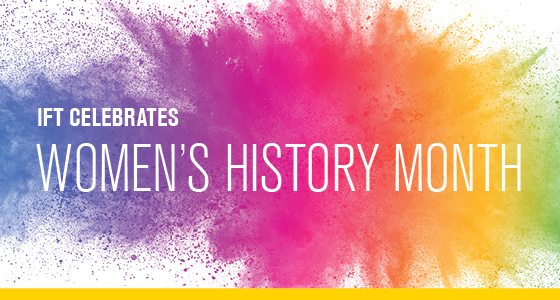
Celebrating Women in the Science of Food
In celebration of Women’s History Month, a panel of female IFT members shared what drew them to the field and gave us a glimpse into what it’s like to be a woman in the science of food.

Historically, fewer women pursued careers in science and technology, but the tide is shifting. According to the National Science Foundation (NSF) and National Science Board (NSB), the number of women in science and engineering occupations or with science and engineering bachelor’s level degrees has doubled over the past two decades. Today, women make up more than 34% of all scientists (engineers excluded). In agricultural and food science, 31% are women.
Almost half of IFT members (45%) are women, painting an even brighter picture for the science of food. In celebration of Women’s History Month, we caught up with five of our female members to learn what drew them to the field and get a glimpse into what it’s like to be a woman in the science of food.
The allure of food science
For some, an interest in food or science at a young age blossomed into a fulfilling career. Tamanna Ramesh, CFS, said she has been curious about the origin of different foods and how they were manufactured since her childhood. This passion and curiosity attracted her to pursue a bachelor’s degree in food engineering, a master’s degree in food science and human nutrition, and eventually, the science of food as a career.
Joy Dell’Aringa said she fell in love with microbiology at 16 when she volunteered at a local hospital and was assigned to the micro lab. She knew quickly this was the scientific area she would pursue. Her first job after college in a QA/QC lab at Dr. Pepper Snapple started her on what she calls a career-long, impacting-making mission, using her love for microbiology to provide the world with safe, quality food.
IFTSA Past President Amy DeJong, PhD, said she’s had a lifelong love of math and science, but she never really understood how to transform her interests into a career. She came across food science by accident and hasn’t looked back. She says she loves being able to apply her love of science toward something that has an enormous impact on our everyday lives.
A career in the science of food was serendipitous for Feeding Tomorrow Past Chair Nancy Moriarity, PhD, as well. After obtaining a PhD in nutritional science, she anticipated getting a job in pharmaceuticals, but life had different plans. She was hired as an oil chemist at Frito-Lay and asked to take a position in product development. She said she was pretty much thrown in and told she would learn—she loved it and continued learning about the science of food throughout her illustrious career.
Like Nancy, Nicole Whitney didn’t take the traditional path into food science either. She received a bachelor’s degree in physiology and neurobiology, but after obtaining a job doing sensory testing and analytical testing in Bigelow Tea’s quality group, she quickly learned how fantastic the food science community is. She said she loves being able to give people something healthy and safe to drink to brighten a moment or two in their days.
The shifting tide
According to Amy, there are many young women in the science of food, so she feels as though she has many peers that she has a lot in common with and can easily relate to. Tamanna agrees. She said in her workplace and professional network, she sees several women in different stages of their career and in leadership roles which is truly empowering, which makes her want to aim higher and contribute significantly to the profession.
But that hasn’t always been the case. Nancy recalls being the only woman with a PhD in R&D when she was hired for her first job. She said the evolution of inclusion in the workplace has been extraordinary since she started her career, not only from a gender perspective, but from an entire diversity perspective.
For Joy, being a woman in the science of food has many fulfilling rewards but has not been without its challenges. She has learned that opportunities must be forged and self-advocacy of vision and contributions is paramount. She said she’s fortunate to have several mentors, women and men, who have modeled inclusive values and encouraged her to amplify her voice. She is heartened to be surrounded by more and more women moving into positions of leadership, influence and authority—a trend she’s confident will continue.
Nicole concurs. She feels there have been many advancements and a lot more opportunities for women to be heard, but there is still a long way to go. She said the food science industry seems to have recognized that. She sees more and more brilliant and talented women in food science succeeding and making their own path through the industry.
The legacy they leave
Although each of these women have taken different paths into the field, are at different stages in their career, and bring unique life experiences to their roles, there is one thing they all agree on—women can and will have an amazing impact on the science of food for many years to come.
The Panel
Amy DeJong, PhD, is a food structure scientist at Mars Wrigley and IFTSA Past President.
Joy Dell’Aringa is a scientific marketing manager at bioMérieux.
Nancy Moriarty, PhD, is a retired R&D leader from PepsiCo and chair of Feeding Tomorrow.
Nicole Whitney is an R&D manager at Bigelow Tea.
Tamanna Ramesh, CFS, is a scientist on the Kraft Heinz Ingredients R&D team.
By Eric Schneider
